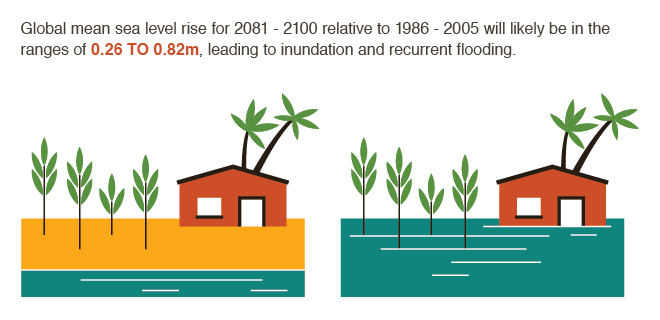Water

Facts
- Climate model simulations for the twenty-first century consistently predict increases in precipitation in high latitudes under the higher-end forcing scenario. In many mid-latitude and subtropical dry regions, mean precipitation will likely decrease, while in many mid-latitude wet regions, mean precipitation will likely increase by the end of this century.
- Glaciers in the Himalayas are retreating and losing mass, but the net amount of runoff water from melting glaciers is expected to rise until at least 2050. This, combined with the predicted increase in precipitation, means that water availability in the region is not likely to decline during this century. River basins that depend on monsoon rains and glacier melt will continue to sustain the increasing water demands expected in these areas (Immerzeel et al. 2013).
- Higher temperatures increase both evaporation and the water-holding capacity of the atmosphere, favouring increased climate variability. For some regions this will result in more intense downpours, leading to more floods, yet longer dry periods between rain events, leading to more drought (Collins et al. 2013). Droughts are projected to intensify, becoming longer, or more frequent, or both, and will mainly effect the subtropics and low- and mid-latitudes (Collins et al. 2013).
- Many areas experienced increases in the number of heavy precipitation events over the second half of the twentieth century, even areas where total precipitation has declined (IPCC 2012).
- Mean sea level is rising, and this will contribute to increases in extreme coastal high-water levels. Locations currently experiencing adverse impacts such as coastal erosion and inundation will likely continue to do so in the future because of increasing sea levels (IPCC 2012).
- People living within about 100 km of a shoreline—one-third of the world's population—will be hit especially hard, because they are particularly susceptible to the effects of rising sea level, including intrusion of saline water into coastal potable water sources.
- Women and children are commonly responsible for collecting water for the household and for gathering fuelwood. Where precipitation declines or temperatures rise, water supplies and availability of fuelwood will decline, increasing burdens on women and children and reducing time available for education or other economic and political activities (UN Women n.d.)
Sources and further reading
- Collins M, Knutti R, Arblaster J, Dufresne JL, Fichefet T, Friedlingstein P, Gao X, Gutowski WJ, Johns T, Krinner G, Shongwe M, Tebaldi C, Weaver AJ, Wehner M. 2013. Long-term Climate Change: Projections, Commitments and Irreversibility. In: Stocker TF, Qin D, Plattner GK, Tignor M, Allen SK, Boschung J, Nauels A, Xia Y, Bex V, Midgley PM, eds. Climate Change 2013: The Physical Science Basis. Contribution of Working Group I to the Fifth Assessment Report of the Intergovernmental Panel on Climate Change. Cambridge and New York: Cambridge University Press.
- Immerzeel WW, Pellicciotti F, Bierkens MFP. 2013. Rising river flows throughout the twenty-first century in two Himalayan glacierized watersheds. Nature Geoscience 6: 742–745. doi:10.1038/ngeo1896.
- [IPCC] Intergovernmental Panel on Climate Change. 2012. Managing the risks of extreme events and disasters to advance climate change adaptation. A Special Report of Working Groups I and II of the Intergovernmental Panel on Climate Change. Cambridge, UK: Cambridge University Press. (Available from https://www.ipcc.ch/pdf/special-reports/srex/SREX_Full_Report.pdf)
- UN Women. n.d. Facts & figures on gender & climate change [webpage]. http://www.unifem.org/partnerships/climate_change/facts_figures.html (Accessed on 7 November 2013)